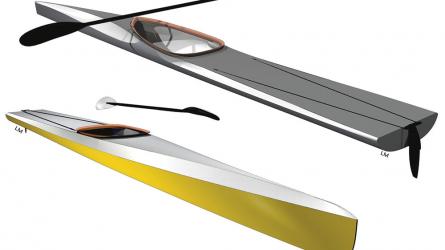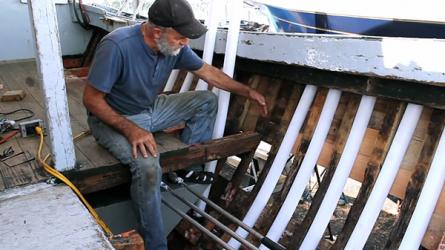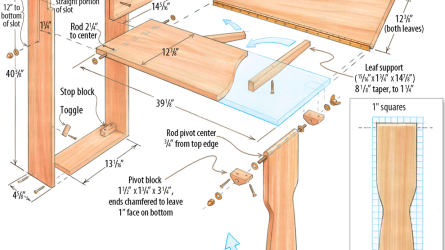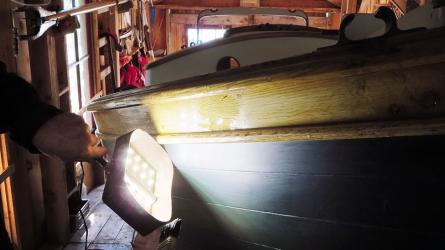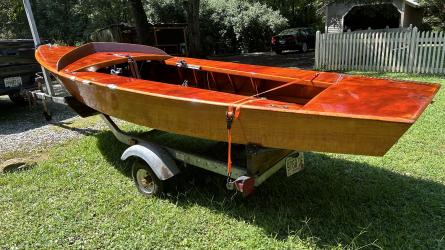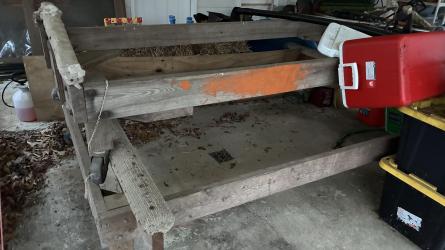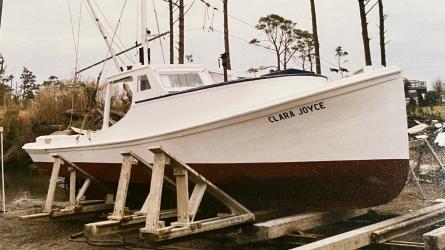A River for the Running
Wooden boats on Idaho’s protected Middle Fork of the Salmon River
Wooden boats on Idaho’s protected Middle Fork of the Salmon River
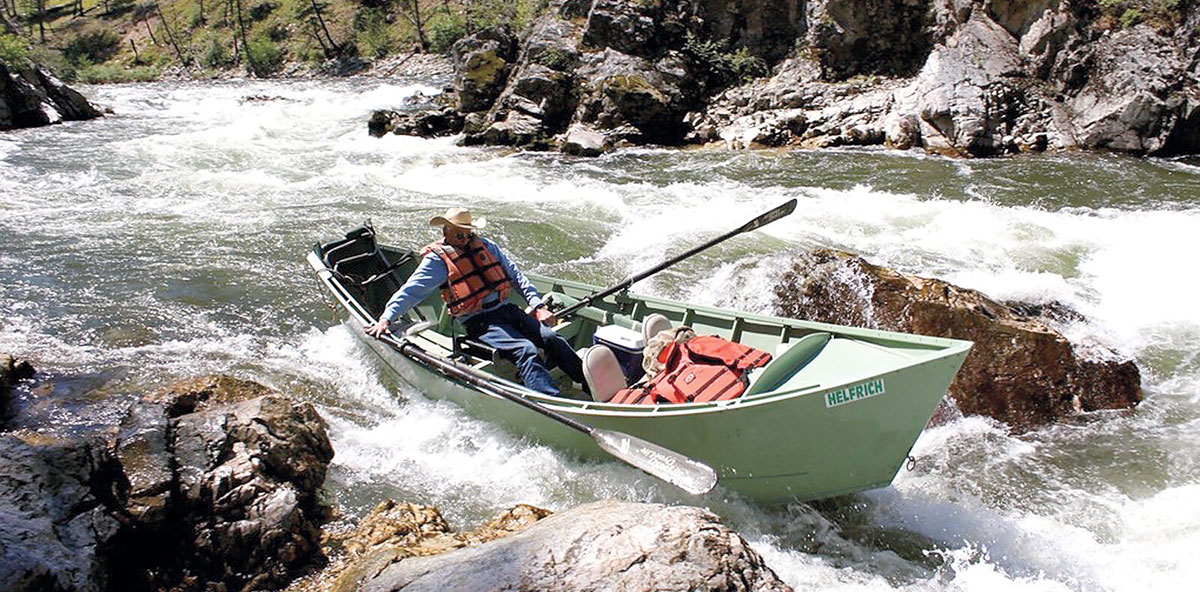
KELSEY HELFRICH
Pistol Rapids is one of the most challenging runs along the Middle Fork of the Salmon River in Idaho. In this 2012 photo, river-running legend Dave Helfrich, then age 80, ships his right oar while leap-frogging the left oar over a boulder just as the boat plunges over a 10’ drop in the Class IV rapid. The blade-forward maneuver can be risky but allows the oar to be deployed very quickly for the next maneuver on the best “line” for the rapid.
We stood on a weathered rock slab worn smooth by the river over thousands of years, just a few feet away from the pour-over at Pistol Creek Rapid. Pistol, one of the most challenging rides on the Middle Fork of the Salmon River in north-central Idaho, is tucked down in the heart of the second-deepest canyon in North America. It starts at Mile Mark 22, and even the first 20 miles of this river were a blur. The Middle Fork, one of the first rivers protected under the Wild and Scenic Rivers Act, is one of the steepest descents I had ever rowed. My arms ached and my legs cramped as we threaded our drift boats through Hell’s Half Mile, Velvet Falls, Murph’s Hole, and a dozen other rapids that had no names. There had been no relief and little time to look around at the breathtaking scenery until we reached Pistol.
Several hundred yards upstream of the rapid, we had pulled to shore, tied off the boats, and walked the dusty dirt path beside the river for a closer look. As we picked our way over rocks and boulders to reach the scouting point, the roar of the rapid increased until we could hardly hear each other talk. Our uphill climb took us to the crest of a little ridge where we looked down and over the source of the noise, a 10′ ledge where the river became a waterfall from one bank to the other.
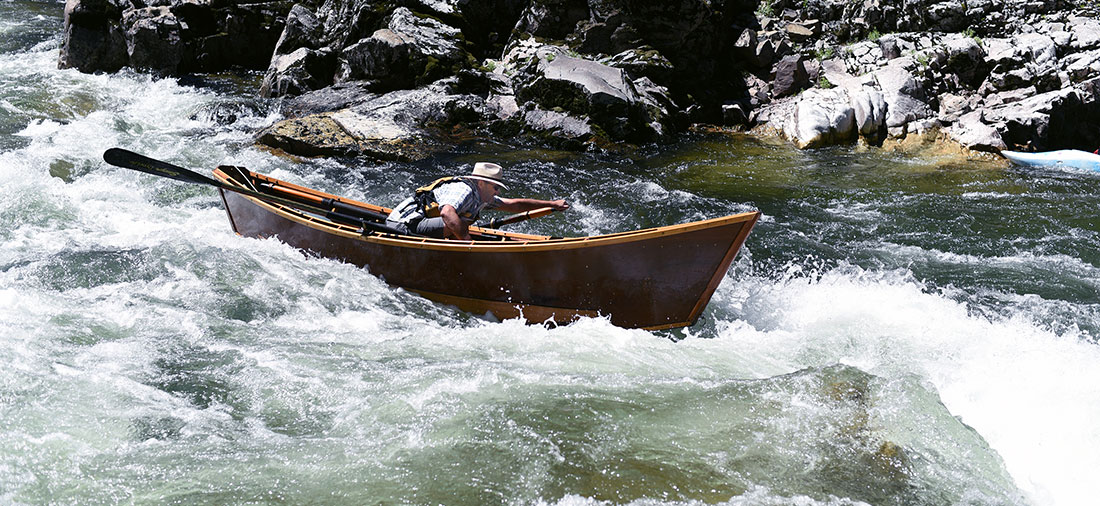
C.J. ADAMS
Author Greg Hatten slides his boat through Lake Creek Rapid.
I felt small in the shadows of Pistol. Steep canyon walls rose up on both sides of the river and blocked the midday sun. Remnants of rock slides broken loose and brought down by the power of heavy rains and flash floods littered the river and pinched it down even more in this narrow slot in the canyon. For several minutes, I stood in silent admiration next to the “River of no Return” and let the challenge and vastness of the Middle Fork wash over me.
We studied our options as the water plunged between jagged, boat-wrecking rocks. Above the loudness, we shouted and pointed at the cleanest line to get six wooden drift boats safely over the drop, between the rocks, and through the rapid. There weren’t a lot of options, so this run would be more about hitting the one clean line than choosing the wrong one.
One week before our trip, the water level had been a foot higher, covering many of the rocks that were now exposed and menacing in Pistol. By late summer, the snowmelt would dwindle and the seasonal lack of rain would make running this rapid all but impossible in a wooden boat. That’s the charm and challenge of a river without a dam to control the flow. It is a wild river, subject to the dynamics of the weather and the consequences that come with it. Deal with it, if you are going to run it.
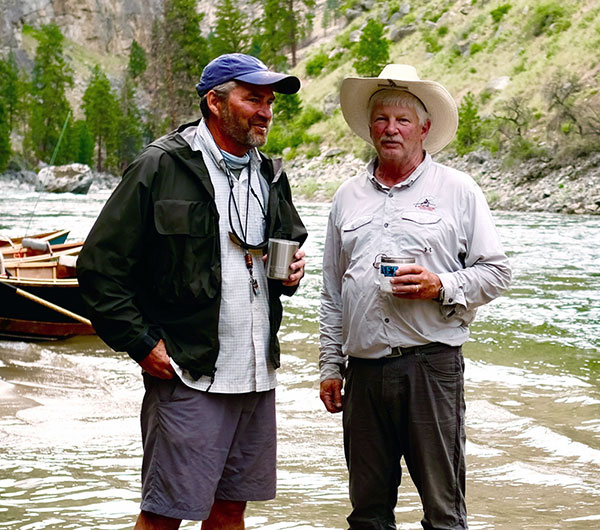
C.J. ADAMS
Author Greg Hatten (left) and Ken Helfrich relax before dinner on the last evening of a 100-mile trip by six wooden drift boats down the Middle Fork of the Salmon River.
The Middle Fork of the Salmon was one of eight original Wild and Scenic Rivers chosen for protection by Congress in 1968. The river runs through 2.3 million acres of pine trees and forests—an area so vast it includes portions of six national forests, several mountain ranges (including the Salmon River, Clearwater, and Bighorn Mountains), and some of the most lush and beautiful valleys and free-flowing tributaries in America.
With a vertical drop of over 3,000′ in just 100 miles, the Middle Fork is one of the steepest of all the Wild and Scenic Rivers. By comparison, the Colorado River through the Grand Canyon drops a little over 2,000 feet in 285 miles. In total, the Middle Fork is the largest protected and federally managed contiguous wilderness area in the United States outside of Alaska. It is spectacular and vast.
The Wild and Scenic Rivers Act was written and sponsored by U.S. Senator Frank Church of Idaho, and it was intended to “protect and preserve certain rivers with outstanding natural, cultural, and recreational values in a free-flowing condition for the enjoyment of present and future generations.” There are now more than 200 rivers in the United States under the protection of this 50-year-old law.
These protected rivers flow down majestic mountains, through deep green forests, through narrow-slot canyons, across high deserts and plains, and snake their way through lush, marshy meadows in every region of the country. The “Wild and Scenic” designation serves as a trip-wire for the rivers and the areas they flow through when someone poses a threat with an initiative to alter the river in some way. It preserves and protects them so river runners, fly fishers, hikers, birdwatchers, and every other sort of outdoor enthusiast can enjoy them in a natural state.
As planned, the first from our group to run the line at the Class IV Pistol was Ken Helfrich. He is a good friend and comes from a notable family of river runners, including his dad, Dave, and his grandfather, Prince, who were pioneers of river running and guiding in the Pacific Northwest. The McKenzie River–style drift boats we run were shaped by their input, based on rowing thousands of miles on the Middle Fork and a wide variety of rivers in Oregon, especially the McKenzie and the Rogue. Ken rows a handcrafted boat built of wood—everyone in our group does, and most of us built the boats we row.
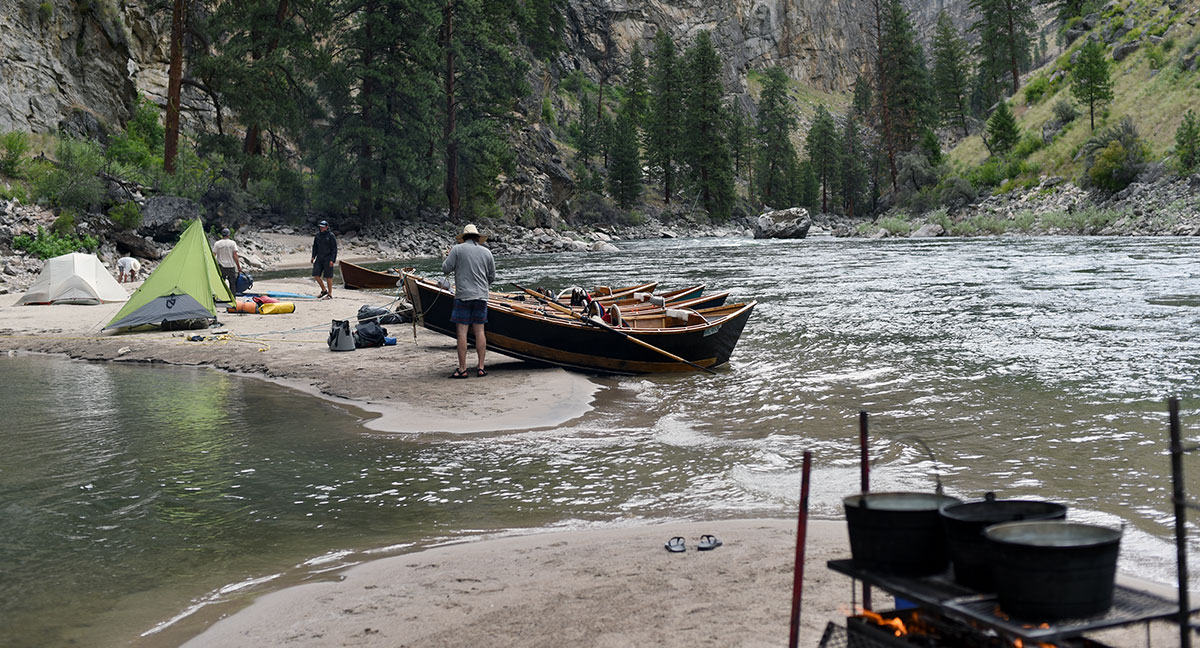
C.J. ADAMS
With the Dutch ovens heating up over an open fire, the adventurers set up their tents and tend to their boats.
There are several drift boat types and materials to choose from these days. Those of us who row wooden boats on wild rivers are quick to defend our choice of craft by rattling off the justifications in rapid-fire succession: the responsiveness of wood on the water; the warmth of a wooden boat on cold rivers; the buoyancy of wood compared to aluminum; and the quiet, natural sound as water slaps the side panels. They are all valid, all true, and all rationalizations for the extra care and attention we give our wooden boats after each run. What we don’t often talk about is the connection that comes with rowing something so lovely and fragile on rivers that are themselves lovely and fragile. That deep connection of the rower, the boat, and the river comes from obsessing over every little detail with the boat and the river.
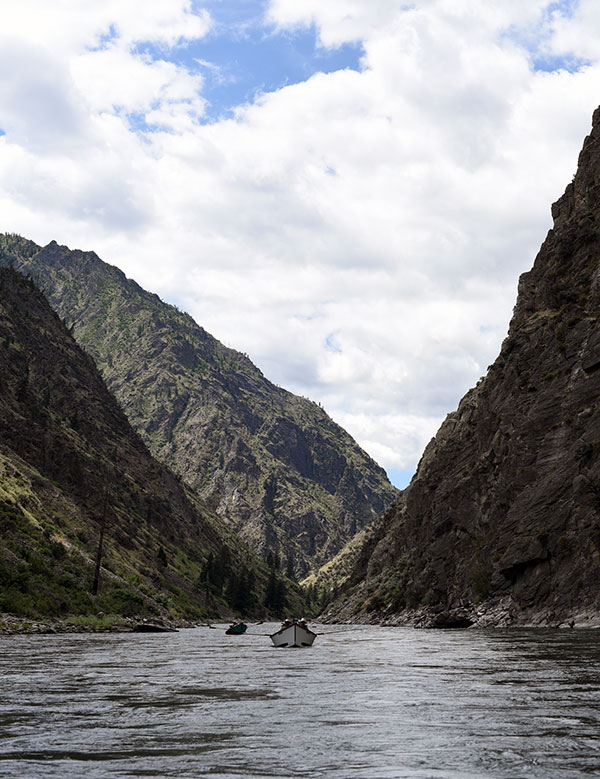
C.J. ADAMS
The Middle Fork of the Salmon River winds through one of the deepest canyons in North America. The river was among the first to be protected under the Wild and Scenic Rivers Act of 1968. In the 100-mile run, the river has a vertical drop of 3,000’—one of the steepest gradients of all the Wild and Scenic Rivers. The author and his friends chose to run the river, much of it involving Class IV rapids, to mark the legislation’s 50th anniversary.
Ashore, the seams are caulked and recaulked, every joint is made tight and waterproof, the hull is fair, and the sheerlines are curvaceous and taut. Every brass screw is countersunk and seated, every sharp edge has been rounded by hand, every inch of the boat has been labored over, sanded, oiled, and carefully varnished.
On the water, these boats are more responsive than most any other type of craft. Yet they are no match for the rocks and boulders we maneuver over and around. We pay close attention to every ripple, every bubble-line, back-eddy, boil, and cross-current, which are all indicators of danger or of safety, of pathways where a wooden boat can and cannot run. Rowing such a boat requires serious intent about reading and running a river. The consequences of anything less than obsessive attention to detail will wreck it, sink it, or both. Connecting with the rhythm of the river is the reward and the pleasure for such an intense approach to running a wild river in a wooden boat.
Those who build and row them will tell you that no two boats are the same, even if they are made from similar plans. Each one is different and has performance characteristics and a personality all its own. It’s the “soul” of a boat that a rower discovers from spending time with it in the shop and time with it on the oars.
The soul of my boat runs deep. At times she’s sporty, at other times she’s graceful, and at still other times she’s rough and rowdy—taking blows off canyon walls and diving off 10' drops. Every scar has a story, every dent has meaning, and she’s even more attractive in this weathered season of her life. She was built from African mahogany and Alaska yellow cedar—a striking contrast of dark and bright woods which makes quite an impression on the water. The sheer, curving as it does around her frames, gives her an elegance that is an unmistakable part of her personality. My woodworking skills and tools were basic, so the build was slow and careful. I obsessed over every detail, practicing each cut, losing sleep over the things I had done and redoing things that weren’t perfect.
I used stainless steel for the fastenings and hardware throughout the boat—carriage bolts, latches, screws, and nuts—and after attaching the side panels as one of the final steps of the build, I didn’t love it. I wished I had used brass or bronze hardware instead of stainless steel to bring out the caramel-colored veins than run through her dark mahogany sides. So one by one, over two hundred times, I broke the wax seal and replaced every single screw along with every nut, bolt, and hinge. When the last brass screw was driven, I stepped back for a look—and finally, I was pleased.
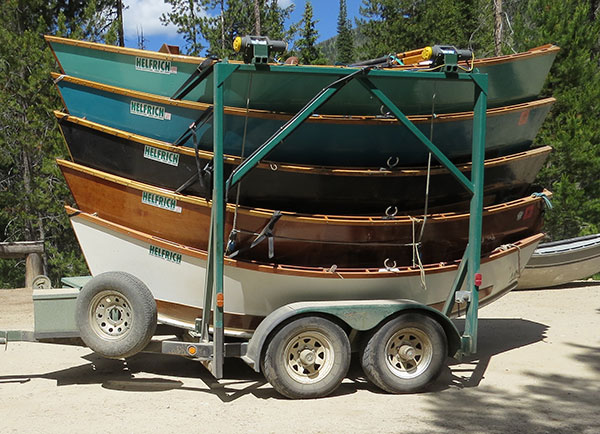
GREG HATTEN
Boats are stacked on a custom-made trailer for transport to and from the river.
Passion for creating a beautiful McKenzie-style drift boat drove me to acquire the skills I needed to build one and row it. It has taken me to some of the most beautiful and remote rivers in North America, and it has delivered me safely through treacherous rapids and life-threatening situations that pushed me to the edge of my physical and mental abilities.
For my group of river runners, it’s the passion that brings us to the river—for the wooden boats, the history, and the art of river-running. Ken has more passion and experience than most, and as he left the scouting overlook and walked the trail back upriver to his boat, I was grateful for the opportunity to watch him tackle one of the hardest rapids I had ever seen.
His boat came sliding around the corner in a graceful “calm before the storm” entrance to Pistol. We could see it being pulled toward the center chute, which Ken himself cautioned about being “too difficult to run at this level,” telling us that “the narrow path between those rock walls is fast and the entrance is awkward—easy to get twisted and hard to correct…. If you make the slightest mistake, those rocks will rip the side of your boat completely off.” With two strong strokes, he broke the grip of the main current and was heading for the opening at our feet. Ken held his left oar steady with the blade digging deep to ferry the boat in a lateral move toward us.
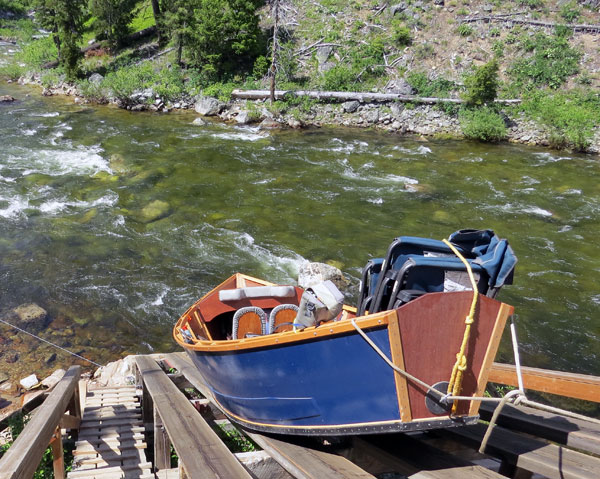
GREG HATTEN
Each wooden boat is skillfully lowered down the long boat slide at Boundary Creek.
We were close enough to see the serious look on his face and the concentration in his eyes as he stared down the rapid and set up his boat to execute the next crucial move, even before finishing the critical move he was already making. As he approached the rocks with only a foot to go, he shipped his right oar “blade forward”; the move would have been more safely made “blade tucked behind” so that if the oar should catch the wall, it would shoot out of the oarlock and into the river behind the oarsman and the boat. If you hit the wall with the “blade forward,” the oar becomes a violent projectile that can do serious harm to the rower and the boat. I’ve heard stories and seen photos of an oar flying straight across the boat and penetrating clean through a quarter inch of plywood on the other side, and I’ve also heard of more than one rower who caught a blade and was catapulted completely out of the boat after being lanced in the ribs by an oar.
On the right run at Pistol at the level we were running, it’s a blade-forward move. It requires split-second timing, tremendous skill, and a lot of nerve. Immediately after Ken’s boat cleared the rock ledge where we stood, he dropped the right blade hard in the water and dug deep to ferry away from a rock outcrop directly in front of him. His boat responded and shot to the left, cleared the cluster of rocks, and finished off one of the sweetest “S-turns” I had ever seen a boat perform. That’s how to run Pistol—minimal oar strokes, major concentration, tremendous skill. Magic.
I scrambled down from the overlook and made my way up the dirt trail back to my boat, reliving Ken’s moves in my head as I went. When I untied my boat and got comfortable in the rowing seat, I took a deep breath and pointed the bow downriver. With one stroke, I was in the thick of it. Rounding the corner, I felt the strong pull of the middle chute and dug deep on the oars to break its grip and cross the lateral to avoid it. I started my ferry angle toward river right. The boat picked up speed and current as I headed toward the dropoff and the rock wall.
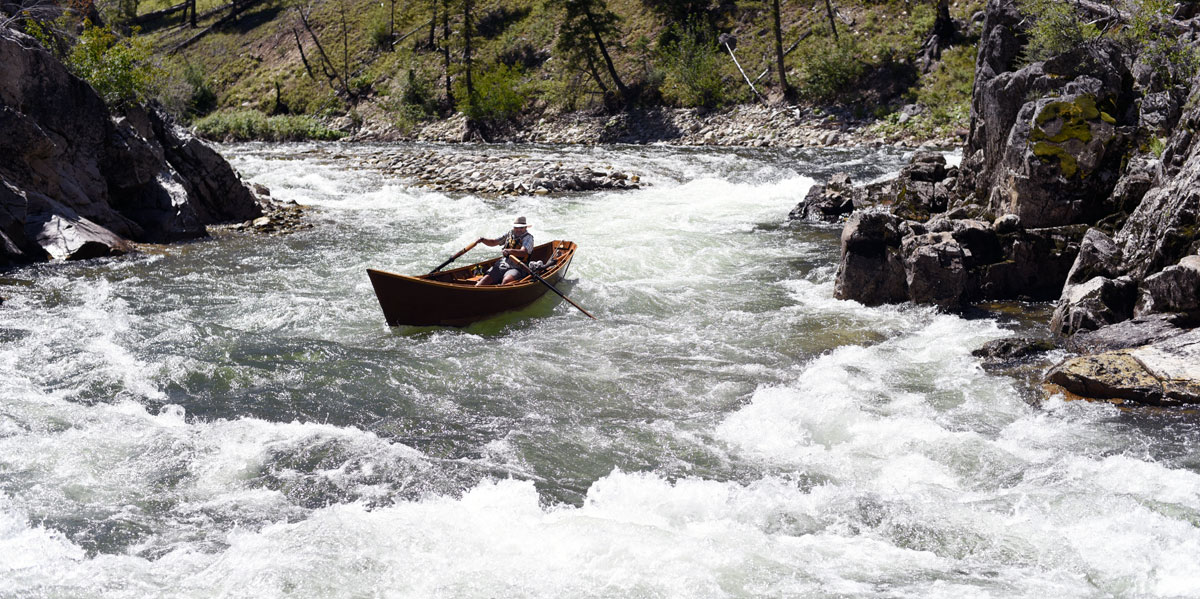
C.J. ADAMS
Author Greg Hatten navigates his wooden drift boat, a McKenzie River–style craft that he built himself, on one of the Middle Fork’s rapids.
Things happened quickly. As I neared the scouting platform, I was moving fast and concentrating hard—if anyone was watching from that rock where I had stood just minutes before, I had no time to notice. I came into the wall a little hot. At the critical moment when my boat was dropping over the ledge, I shipped the right oar forward, held my breath, and held my gaze. I scraped the wall with the tip of my oar and almost stuck it—but didn’t.
I exhaled. The second after I cleared the rocks with the forward half of the boat, I dropped the right blade and copied Ken’s moves stroke-for-stroke. The boat responded instantly to my touch, shot sharply to the left, and everything after that happened fast with the moves in my head somehow coming out in my arms and my oars. In what seemed like seconds, it was over. I eddied out at the bottom of the S curve, looking back upstream at the next wooden boat approaching the drop.
Around the campfire that night, I reflected on the day and the hundreds of Wild and Scenic River rapids I have run in my little wooden boat over the years. While each one is unique, there are similarities: high canyon walls; steep river drops; powerful, raging water; and butterflies in my stomach. All of those rapids offer river runners a challenge that requires physical and mental skills, along with grit and nerve. I worry about a set of eyes with a different agenda standing on the slick rock beside Pistol—or any rapid on our Wild and Scenic Rivers—with a perspective much different than mine. Through a different lens, an onlooker might see a potential dam site, a reservoir, a casino, a uranium mine, or any number of revenue-generating ideas. There are constant pressures to exploit these special places and compromise their Wild and Scenic nature.
Could it really happen, you might ask? Consider the Grand Canyon—one of the seven natural wonders of the world. Congress was one vote away from “sinking it” with two dams in 1964. This in a place where Theodore Roosevelt himself cautioned, “Leave it as it is. The ages have been at work on it and man can only mar it.” We have disregarded those words in every era since they were spoken in 1910, and we continue to do so today. Currently, there are proposals for trams, casinos, housing developments, and expanded uranium mining rights to the Grand Canyon. These are attacks on a place with National Monument, Wild and Scenic River, and National Park designations and protections. The canyon draws millions of visitors and hundreds of millions of dollars to the local economy just as it is, yet it continues to be the target of commercial interests that would compromise the status and forever destroy its character.
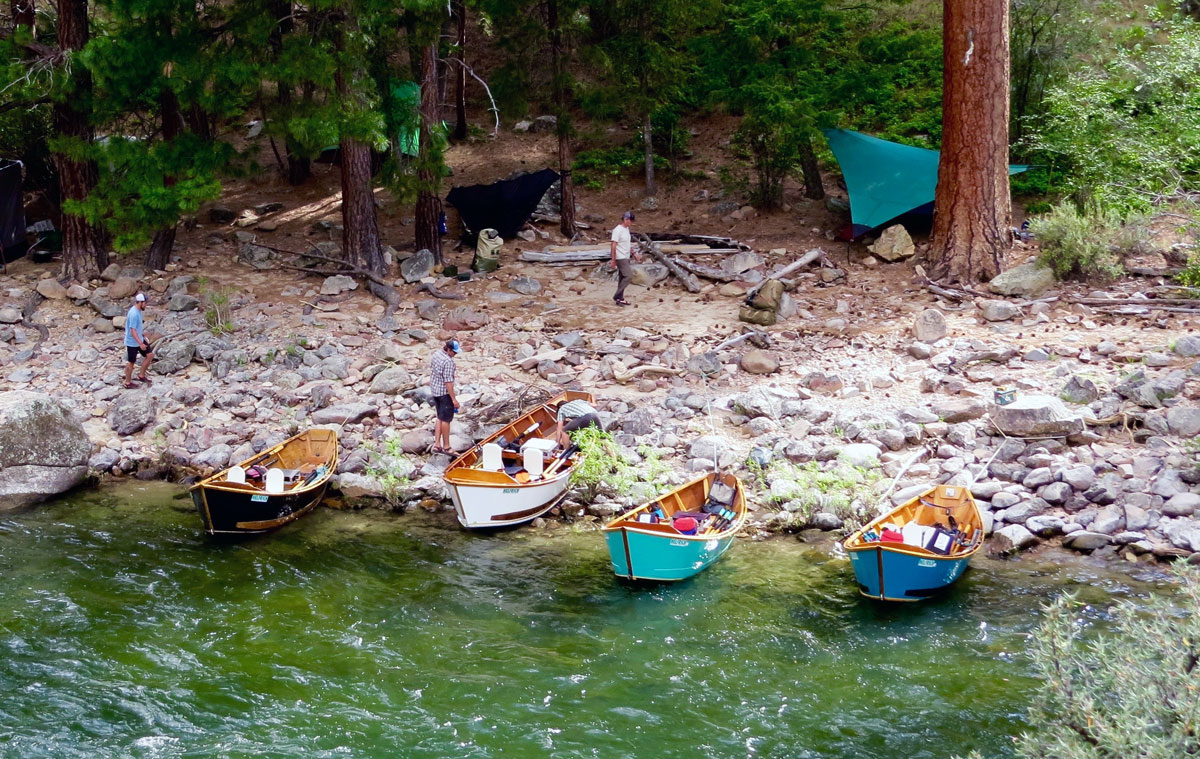
GREG HATTEN
Wooden drift boats, which were developed for running western whitewater rivers, look right at home at camp.
On the 50th anniversary of the Wild and Scenic Rivers Act, it’s a good time to remember why this law was established in the first place, as Senator Frank Church, who served in Congress from 1957 to 1981, stated:
“The great purpose of this act is to set aside a reasonable part of the vanishing wilderness, to make certain that generations of Americans yet unborn will know what it is to experience life on undeveloped, unoccupied land in the same form and character as the Creator fashioned it.... It is a great spiritual experience. Unless we preserve some opportunity for future generations to have the same experience, we shall have dishonored our trust.”
As a river-running enthusiast, I’m grateful that we have a measure of protection for our Wild and Scenic Rivers. My interests are selfish: I want the rivers and the area around them to remain in a wild and natural state so we can test our skills on the rapids in wooden boats, rafts, and kayaks for many years to come. One day I will show my grandkids these wild places, and even if we can’t visit them all, I want them to know they exist. 
Greg Hatten is an outdoor adventurer, freelance writer, and photographer. His passion for rowing wooden boats on challenging rivers has led him to more than 15 National Parks and more than 100 Wild and Scenic Rivers, covering a thousand river miles and hundreds of treacherous rapids. When he isn’t rowing and writing, he launches new consumer products at retail, having built a successful consulting practice working with inventors and entrepreneurs from around the world.
